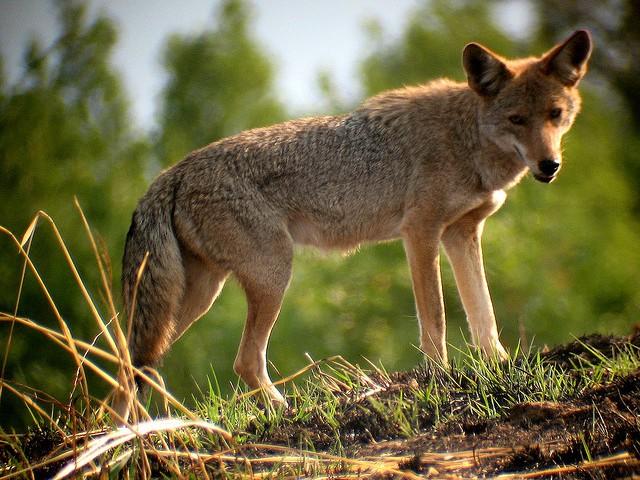
Section Branding
Header Content
Is that a coyote or dog in your yard? Here’s how to know & tips to stay safe in Georgia
Primary Content

Winter time often means less insects bugging you outside. However, winter brings its own set of pests and predators out to roam.
One of those predators is the aloof coyote, which has its mating season at the peak of winter and into the early spring (January - March) in Georgia.
And while they may look like your average dog, perhaps even cute, they bite back and are quite aggressive during dusk and dawn, which are their most active times.
So, how can you really tell if the fluffy creature is a coyote and not just a stray or lost pup? Here’s what to know:
How to distinguish between coyotes and dogs
Although they may be hard to distinguish from a regular dog, there are several characteristics unique to coyotes. Here’s what experts say:
Why do they look so much like dogs?
According to Field and Stream writer Matthew Every: “Dogs and coyotes are part of the same genus, Canis, but because a coyote has never been domesticated, they have different physical attributes, a different diet, different habits, and a more wiley disposition than dogs.”
You may be able to think of a few dog breeds that look similar to coyotes right off the bat. For example, Siberian Huskys, Tamaskans, or even the Saarloos wolf dog. But how can you be sure they aren’t a fierce coyote?
Here are some key differences to look for:
Weight
While dogs can weigh anywhere from 5 to 150 pounds, coyotes typically weigh between 20 and 50 pounds.
Coat and coloring
“Coyotes only come in a few flavors. Their coats are usually brown and tan mixed with gray and black. There are also all-black coyotes and strawberry-blonde coyotes,” said Every. Their coats are also thick with an undercoat for winter, but dogs have a variety of coats, colors and patterns, all with different textures and thickness.
Claws and size of prints
If you can’t get a good glimpse of the animal, but you later see tracks, here’s what to look for:
“The paw prints of coyotes are oval-shaped, and their toes are all aligned and pointing forward,” said biologist and science writer, Genevieve Dugal.
Dog prints are wider and extended, while coyote prints are around 2.5 to 3.5 inches long. And claws are another indicator because dog claws are more rounded, while coyote claws are sharp and thin.
Ears and tail
Last but not least, the ears and tails of coyotes are noticeably different from the ears and tails of a normal canine.
“Coyotes’ ears are pointed and erect, similar to those of a German Shepherd but thinner,” said Dugal.
And their tails are long and bushier than most dogs'.
Dugal said to look at the tip of the animal’s tail, too, because the “tip of their tail is almost always black” if it’s a coyote.
Dugal also mentioned the way the tail sits as a coyote walks, as it stays down when they walk or run, but dogs will usually have a tail that is up when they are active.
Tips to stay safe from coyotes
According to the Georgia Department of Natural Resources (Wildlife Resource Division), here are some tips to follow:
“Simply seeing a coyote is not a cause for concern. Coyotes can easily adapt to human-dominated environments, so it is common for conflict to arise from sharing space with people,” said a representative with the Georgia DNR.
Here’s what to do if you see one around:
- Do not feed or approach coyotes.
- Secure food attractants such as garbage, pet food, and bird seed.
- Feed pets indoors when possible. If pets must be fed outside, remove food bowls when finished.
- Remove excess bird seed on the ground that may be attracting mice to your yard, which in turn attracts coyotes.
- Haze, or scare, coyotes out of your yard. Coyotes are naturally wary of people. Consistent hazing helps keep this fear of people intact. For example, bang pots and pans, yell, or use an air horn.
- Use a water hose or motion activated sprinkler to move coyotes a safe distance away.
- Close off crawl spaces to prevent coyotes from using these spaces as dens.
Do you have more questions about coyotes? Let me know in the comments or email me at cmadden@mcclatchy.com.
This story comes to GPB through a reporting partnership with the Macon Telegraph

